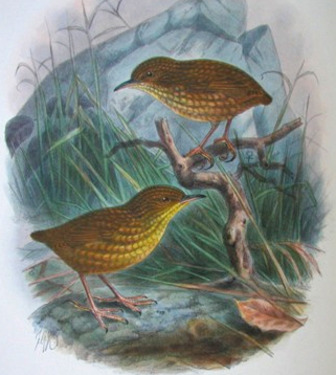Traversia lyalli
It is the best known of the extremely few flightless passerines known to science , all of which were inhabitants of islands and are now extinct. The others were relatives of Xenicus and the Long-legged Bunting from Tenerife, all of which were only discovered recently and became extinct in prehistoric times. In addition, the Bush Wren and the Chatham Islands Fernbird were largely flightless.

The Traversia lyalli is classified as Extinct (EX), there is no reasonable doubt that the last individual has died.
the bird, as Traversia lyalli, which is read by Ernst Hartert at the British Ornithologists' Club meeting. Philip Sclater, the Club's president and editor of the Ibis who knows of Buller's article in preparation, brings up the matter to Hartert, who says he cannot withdraw Rothschild's description without consent. More
Summary Traversia lyalli is only known from recent times from Stephen's Island, New Zealand1, although it is common in fossil deposits from both of the main islands4. It is not thought to have existed beyond 1894. Ecology: The species was flightless and restricted to the rocky ground2. Threats Construction of a lighthouse on Stephens Island in 1894 led to the clearance of most of the island's forest, with predation by the lighthouse keeper's cat delivering the species's coup-de-grace3. More
The fate of Traversia lyalli is a classic but pathetic tale of New Zealand natural history. In 1894, at a meeting of the Ornithologists' Club in London, a well-known collector the Hon W Rothschild, announced his possession of ten specimens of a rare bird which he had obtained from Henry Travers in Wellington, who got them from the Stephens Island lighthouse keeper. The remarkable find had actually been accomplished by the very active lighthouse keeper's cat. More
Family : Acanthisittidae
Genus : Traversia
Species : lyalli
Authority : (Rothschild, 1894)

